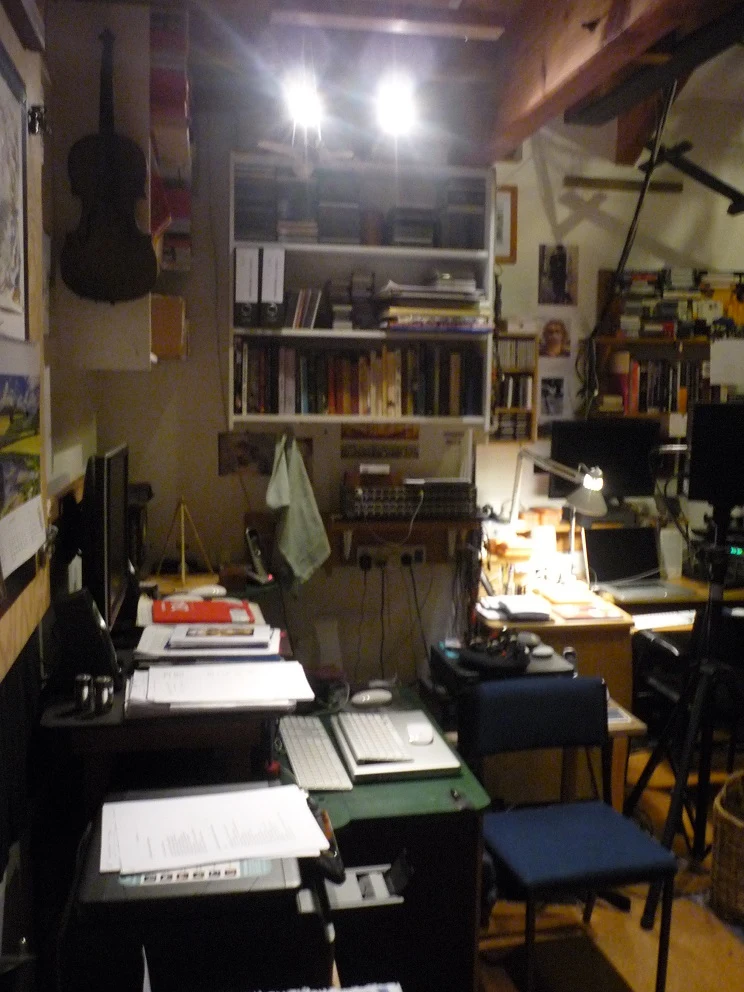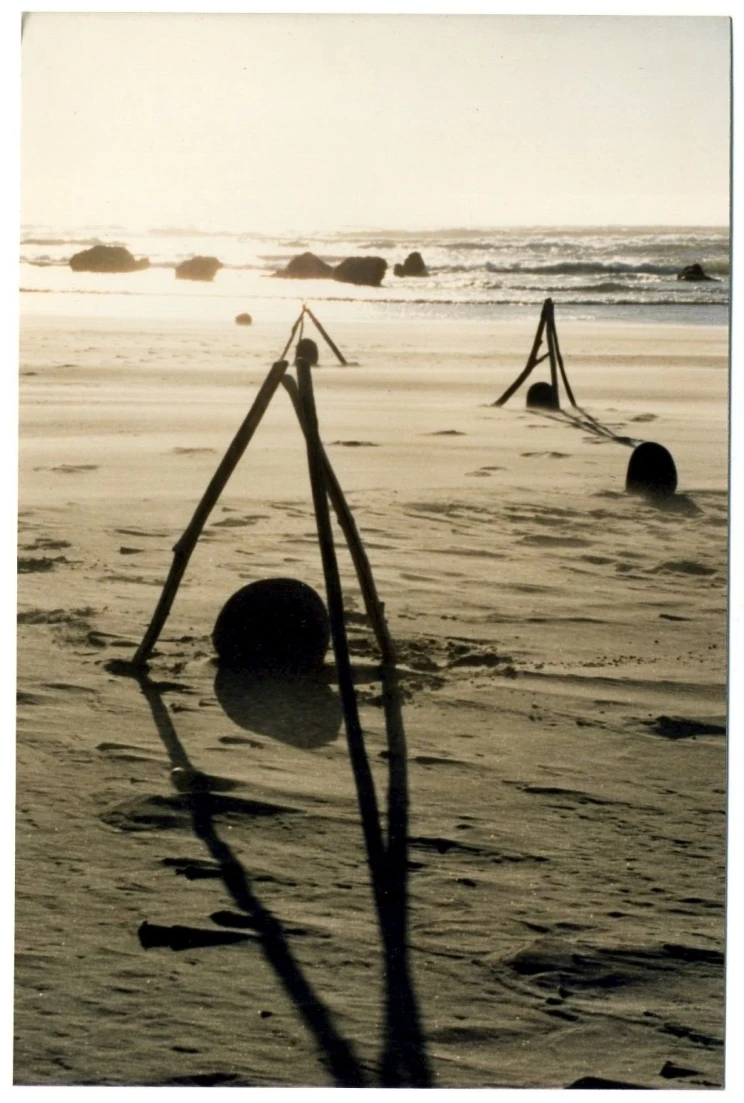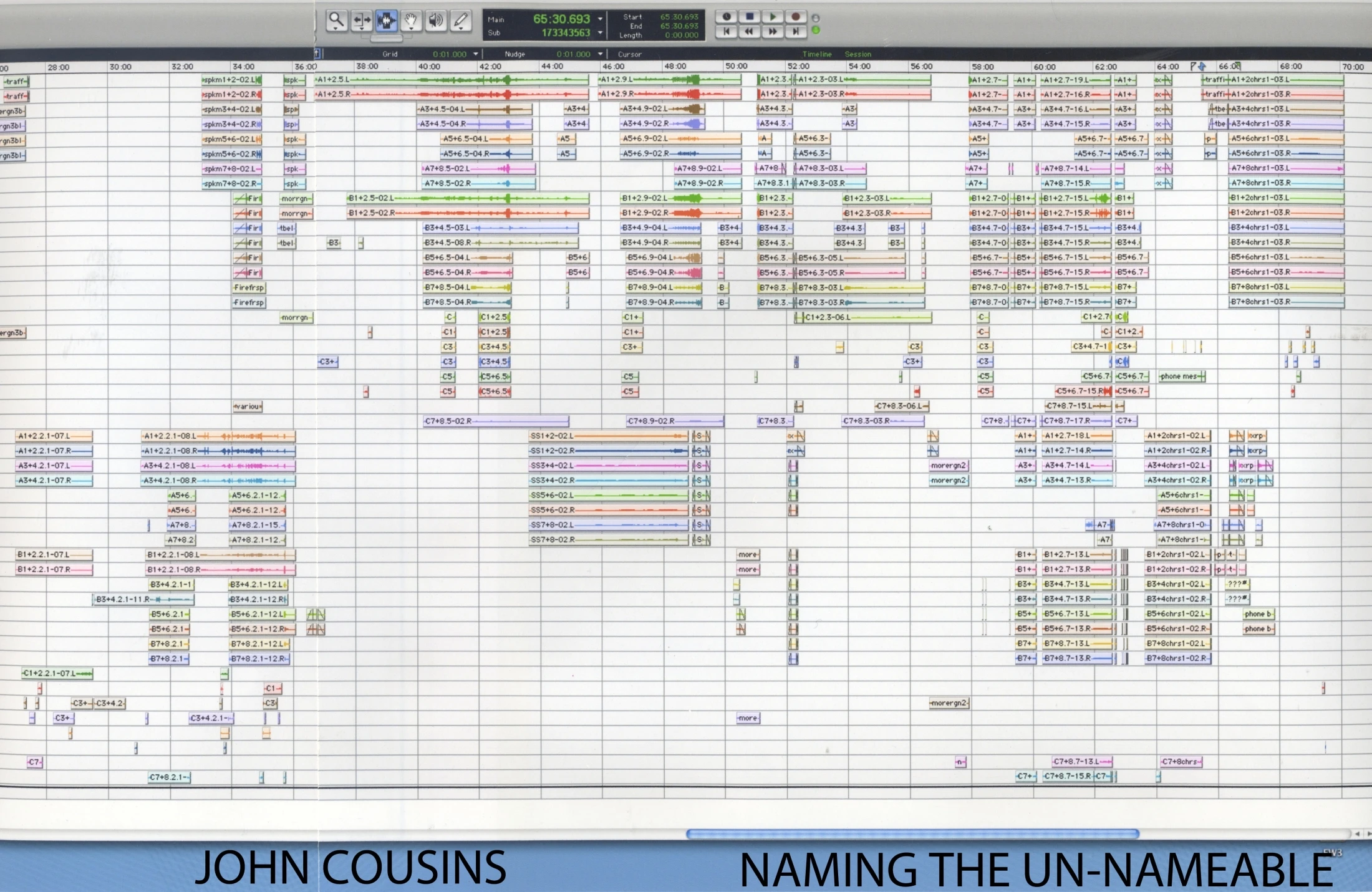Tales from the Acousmonium – Part 2
The Cousins collection of audio recordings and acousmatic music presents some digital preservation challenges. Read about how we have archived this new collection of NZ composer and sonic artist, John Cousins.
Preserving the John Cousins Collection
Last week we blogged about the newly available collection of sonic artist John Cousins: see Tales from the Acousmonium – Part 1.
Cousins is one of the most inventive of his generation of New Zealand composers, and his innovative approaches are very much reflected in his digital archive.
In this blog sequel, we look more closely at the special challenges of preserving this complex body of material.

Photomontage created for the multimedia installation Azimuth Projection (1988-89). Ref: MSDL-4824. Alexander Turnbull Library.
The John Cousins Collection contains an extensive archive of digital materials, including video and audio recordings and versions of works, source audio files, talks and interviews, photographic materials, and supporting documentation. We've included some examples of the audio as part of this blog.
A long journey
Holding over 8,000 files, the digital archive in sonic artist John Cousins’ collection is one of the largest in the Archive of New Zealand Music. How did it come to be preserved at the Turnbull Library?
The story begins with the events of 4 September 2010, when an earthquake centred near Darfield caused several fatalities and widespread damage to Christchurch. Prompted by the destruction wrought around him, Christchurch-based John Cousins contacted the Library about how he might safeguard his musical archives. Unfortunately, on 22 February 2011, there was an even more deadly and destructive quake, which delayed discussions for much longer.

Interior view of part of Studio 174 (2016). Photo: Michael Brown
Cousins' studio in Christchurch
Eventually, a visit to Cousins’ studio in Christchurch was arranged to view his collection of papers, photographs, recordings, and artworks.
As his creative practice had been principally born-digital since the early 2000s, we also talked at length about what might be preserved from his extensive digital archive.
Footsteps in a pine forest
Recordings of the sound of footsteps in a pine forest, very closely microphoned. Ref: MSDL-5241. Alexander Turnbull Library.
The Digital Archive
One of the main challenges presented by Cousins’ archive related to the software used for the multi-channel works he has created since the early 2000s. These works are designed to be played back in the Acousmonium, a specially-calibrated array of 26 speakers that audiences can visit at Cousins’ studio in Christchurch.
Since the 1990s, Cousins has employed the digital audio workstation (DAW) application Pro Tools to digitise analogue recordings, edit and manipulate them, and create master stems for playback in the Acousmonium.
Pro Tools digital audio workstation
DAW project files
The Pro Tools project files (.ptx) for Cousins’ multi-channel works give the most detailed record of his creative processes. Ideally, we would have liked to have preserved these. Unfortunately, as explained in a blog relating to the Luke Rowell Digital Music Collection, DAW project files present great difficulties for digital preservation efforts.
Rather than attempt to archive the DAW files, Cousins and the Library agreed to preserve two sets of closely-related material. First were the source audio clips that Cousins uses to create his works. These files document the wide range of sounds he has gathered and the sonic transformations applied to them.
Second were the multi-channel masters and specification files for the resulting acousmatic works: all are easily-preservable file types that will enable Cousins’ art to continue to be experienced into the future as fully intended (stereo versions are also preserved for more convenient access).
Both sets of digital material will provide researchers with many insights into Cousins’ creativity.
Steel railing resonating in the wind, Isle of Skye
Digital transformation of a recording made of galvanised steel railing on a clifftop in a high wind made on the island of Skye, Scotland. Ref: MSDL-5236. Alexander Turnbull Library.
Challenges of digital preservation
However, even getting these audio files into a state that the Library could preserve proved tough work. Cousins uses a macOS, while the Library’s IT environment is Windows-based. The transfer between operating systems resulted in a large proportion of filenames in the collection becoming problematic due to length, use of special characters and punctuation marks, or missing file extensions.
There also turned out to be a lot of duplication within the digital archive: not all the files needed to be permanently preserved, but which ones were they?
Another issue was that the meaning of many files was not obvious from the content, filename, or location in the archive’s folder structure. Without more contextual information, the digital archive could be difficult for future researchers to understand.

Burial photomontage created for the multi-monitor installation Reciprocal Traverses (1988). Ref: MSDL-4824. Alexander Turnbull Library.
The blessings of lockdown
While the COVID-19 pandemic has had a devastating impact on New Zealand, there have been – ironically – some upsides for certain types of work. The 2020 lockdown meant that Library staff could devote significant work from home time to digital collections such as John Cousins'. We were thus able to make significant headway on the issues described above.
Throughout the March to May 2020 lockdown and for months afterwards, Michael Brown (Curator, Music) and John Cousins spent several hours per week on the telephone, while both scrolling through the digital archive on their screens.
These conversations were invaluable in helping determine duplicate material, unknown file types, copyright status, and — most importantly — the context and meaning of the digital materials. The information was logged in a spreadsheet to assist further curatorial, technical, and descriptive tasks.
Of the 19,000 files originally deposited, around 8,000 were to be retained.
This was not the end of our work, however! Many hours were still needed to rename files, migrate some to more stable formats, arrange and describe the collection, and load the final set to the National Digital Heritage Archive.
Access the John Cousins Collection (ATL-Group-00514)
Spectral processing sound
Abstract sound created using spectral processing. Ref: MSDL-5195. Alexander Turnbull Library.
Source Audio
To get a more focused sense of the collection we went through every folder, documenting the number of files and subfolders, listening to the audio, and summarising content using keywords. This information was stored in a new spreadsheet which let us visualise the depth and range of content at a glance.
In arranging and describing the digital archive, we replicated the original folder structure used by John Cousins, in line with the archival principle of original order.
The Source Audio folder, however, proved particularly challenging. It contained hundreds of nested folders (sometimes up to 7 or 8 layers deep), many named in the Cousins’ bespoke shorthand. Our goal here was to simplify the structure while retaining, as much as possible, the grouping of files as originally organised by the artist.
The original folder-subfolder provenance for the files is also recorded in the “Acquisition Information” field for each descriptive record, as shown below.

Detail from a Tiaki descriptive record showing folder-subfolder provenance. Ref: MSDL-5144. Alexander Turnbull Library.
Browse the Source Audio subseries (Series-6726-11)
Digital transformations
Describing the audio content of each folder was another challenge, generally made easier by Cousins’ tendency to group sounds from specific sources and their processed variations in folders together. We opted for the term “digital transformations” as a catch-all term to describe audio created by manipulating sounds using computer-based processing.
When creating his source audio files, Cousins’ often used abbreviations in the filenames to denote how the audio had been processed. Many feature long strings of these cryptic letter combinations.
Ocean surf recorded at Birdling’s Flat
The file “birds18grm22.wav”, one of many digital transformations using GRM software of ocean surf recorded at Birdling’s Flat. Ref: MSDL-5164. Alexander Turnbull Library.
Some abbreviations refer to common effects (e.g., “rev” = reverb). Others refer to special software used. The letters “grm” in a filename or folder name, as used for instance in the sound clip above, meant that audio had been processed with plugins developed by Ina-GRM (Groupe de Recherches Musicales de l'Institut National de l'Audiovisuel) in Paris, France.
Other applications used to transform digital samples include Alchemy, Soundmaker, and the programme Soundmagic Spectral, created by New Zealand composer Michael Norris.
We concluded that researchers would benefit from knowing how to decode these abbreviations, as it would clarify both the sounds' provenance and Cousins’ creative practices. John agreed and helped compile a spreadsheet to assist in deciphering the filenames.
List of abbreviations used in Source Files filenames with associated definitions
The SDII files
The ‘Source Audio’ folder also contained numerous Sound Designer II files (SDII or .sd2) sprinkled throughout the folder structure. This legacy audio format was developed by the company Digidesign in the late 1980s for use with their early DAW, Sound Designer, a precursor to Pro Tools which ran only on Apple Macintosh computers.
Unfortunately, when transferring the SDII files from John Cousins’ macOS hard drive to the Library’s Windows-formatted storage they become corrupted. Most critically, all the files lost their ‘resource forks’. This section of the file carries information such as the audio sample rate, bit-depth, and the number of audio channels. Without resource forks, the SDII files were rendered unreadable as audio.
After much research, we decided the best strategy to preserve these files was to keep them in a macOS environment where, using iTunes, we would convert them to the widely-supported cross-platform WAV format. In this form, the files could be easily transferred across to the Library’s system.
A further stumbling block then became apparent! Around 2010, the SDII format ceased to be supported by iTunes. Fortunately, the Library had a 2010 model MacBook running OS X version 10.6.8 and iTunes version 11.4, on which we could undertake the conversion. While a few files still proved problematic – for some unknown reason – we were able to convert the remaining SD2s using the DAW Logic Pro.
We had several more adventures in digital preservation, including ‘The case of the AIFF audio files with missing headers’, but we’ll leave these tales for another occasion.
In early 2022, we applied the finishing touches to the collection, which is now available for your perusal.
John Cousins Collection
It's been a long and very interesting journey and we are delighted to have this colleciton of the creative work of composer John Cousins in our care as part of the New Zealand Archive of Music.
Have a look at the extensive archive of digital materials, including video and audio recordings and versions of works, source audio files, talks and interviews, photographic materials, and supporting documentation in the collection.
John Cousins Collection (ATL-Group-00514)

Stone and driftwood sculpture at Paturau Beach. Ref: MSDL-5258. Alexander Turnbull Library.
This blog was co-written with Thomas Lambert, who worked as a digital archivist on the collection. Thanks also to the wider who worked on this collection: Valerie Love, Flora Feltham, Zach Webber, and Jay Gattuso.
